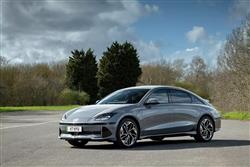Hyundai IONIQ 6 - ABC Leasing
How will you view?
This is a sample, showing 30 seconds of each section.
SLEEK SIX DREAM(some text hidden)
By Jonathan Crouch
Ten Second Review word count: 66
The race is on to create the most streamlined passenger EV - and here's Hyundai's contender, the IONIQ 6, which slips through the air at just 0.21Cd. The result is a possible 338 mile range that beats many obvious rivals. And brings this saloon counterpart to the IONIQ 5 right into contention if you're looking at cars like the Polestar 2 and the Tesla Model 3.
Background word count: 182
Hyundai has lately reinvented itself as creator of interesting cars - particularly EVs. The IONIQ 5 of 2020 really caused a stir and this its saloon showroom stablemate the IONIQ 6 will get the neighbours talking too. There's no way you would know that those two cars share everything under the skin because the IONIQ 6 looks completely different - not only to the '5' but to everything else on the road. The shape's said to be inspired by 'streamliner' models of the 1930s and '40s. Simon Loasby, Hyundai's Head of Styling, cites the 1947 Stout Scarab, the Phantom Corsair and the Saab Ursaab as major influences. No, we don't remember them either. Anyway, the whole point of going the 'streamliner' route was for Loasby and his team to gain the industry's first sub-0.20Cd drag factor coefficient. They didn't quite manage that but got close enough (0.21Cd) to make possible a class-leading driving range figure. That might get you interested in this car, but if you choose it, it'll be because of one thing and one thing only: the way it looks.
Driving Experience word count: 296
There would be no point in this car looking like it does if all the efforts of streamlining didn't make a radical difference to range. Well here's the figure; 338 miles - which applies to the 228PS rear motor model we're trying here: a 325PS dual motor AWD version is also available (which manages 322 miles). Both variants use a 77.4kWh battery and should be able to regularly crest 300 miles between charges. The streamlining necessary to achieve these range figures obviously helps refinement too. Don't be fooled by that 911-style rear end into assuming this to be some kind of sports saloon - it isn't. Though it's as quick as many sedans of that sort, the AWD version making 62mph from rest in just 5.1s. There are three main drive settings ('Eco', 'Normal' and 'Sport') and brake regen steering wheel paddles with a max 'i-Pedal' setting that slows the car noticeably off-throttle. With top 'Ultimate' trim, Hyundai includes 'Active Sound Design' (e-ASD), a technology that gives the IONIQ 6 a unique and defining sound under acceleration. It's certainly audibly futuristic but having tried it once, you'll probably quickly turn it off. Customers choosing 'Ultimate' specification can also specify the option of digital side mirrors. Away from matters digital and EV, on the move you'd expect the drive experience to be very little different from that of the IONIQ 5 since the mechanicals are almost exactly the same. Fortunately, it's a little better, probably because of this saloon model's slightly lower centre of gravity. It seems to have a different tune to its 5-link rear suspension too, less unsettled by poorer surfaces. But the car doesn't ever ride them particularly smoothly and pot holes trouble this Hyundai far more than you'd hope with a luxury saloon.
Pictures (High res disabled)

.jpg)
.jpg)
.jpg)
.jpg)
.jpg)
.jpg)
.jpg)
.jpg)

Scoring
Category: Compact Car
| Performance | |
| Handling | |
| Comfort | |
| Space | |
| Styling | |
| Build | |
| Value | |
| Equipment | |
| Economy | 80% |
| Depreciation | 60% |
| Insurance | 60% |
| Total | 66% |